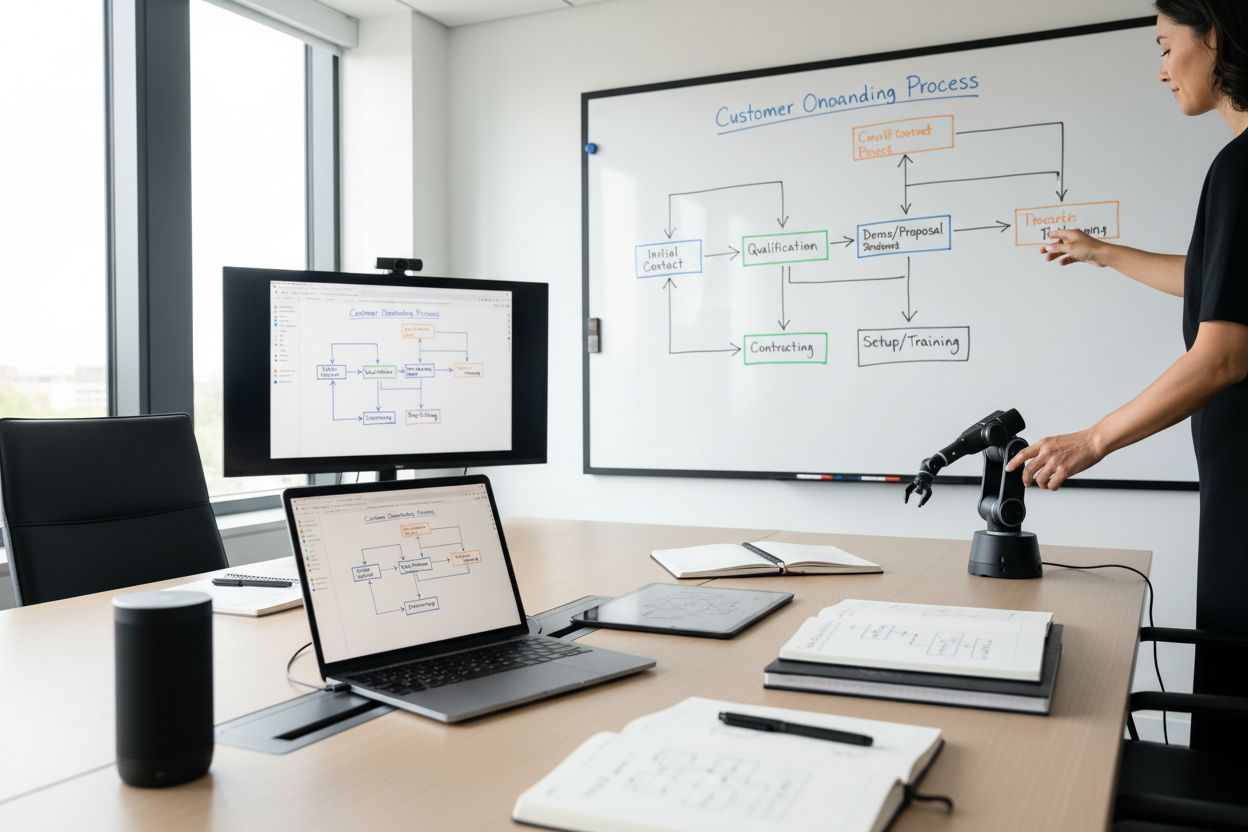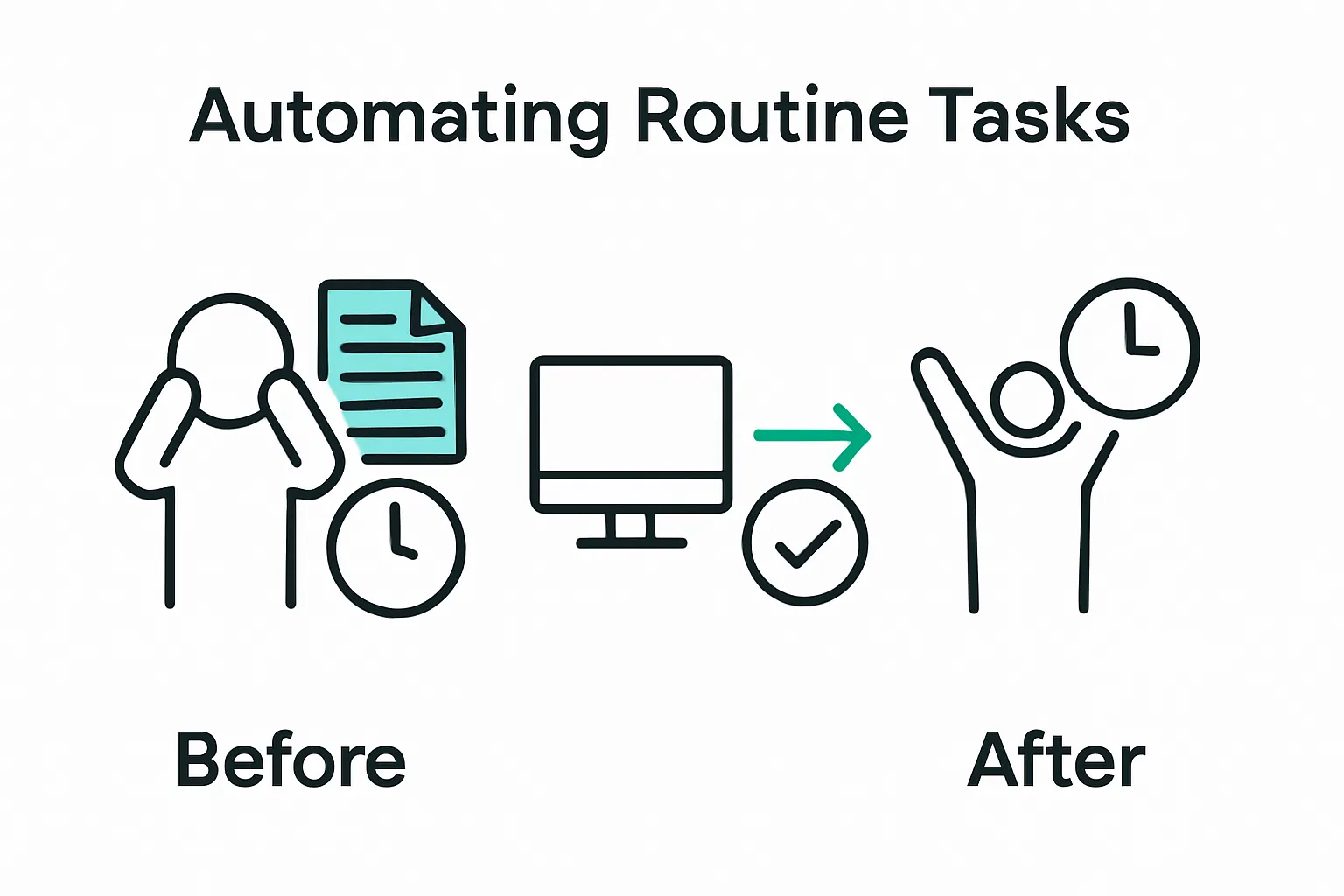Workplace Automation Tutorial: Streamline Your Business Today

Automating your workplace sounds futuristic, but it is already driving massive improvements for companies everywhere. Research shows that businesses mapping their workflows in detail see up to 30 percent faster automation adoption. You might think the toughest part is picking the right tools. Instead, the real secret lies in understanding your actual day-to-day processes before technology even comes into play.
Table of Contents
- Step 1: Assess Current Workplace Processes
- Step 2: Identify Automation Opportunities
- Step 3: Choose the Right Automation Tools
- Step 4: Implement Automation Solutions
- Step 5: Test and Validate Automated Processes
- Step 6: Monitor and Optimize Automation Performance
Quick Summary
| Key Point | Explanation |
|---|---|
| 1. Analyze current workflows thoroughly | Document existing processes to identify inefficiencies and improvement opportunities. This foundation is essential for effective automation planning. |
| 2. Identify precise automation opportunities | Focus on repetitive, time-consuming tasks to empower employees. Engage staff insights for discovering areas needing improvement. |
| 3. Select compatible automation tools | Choose tools that easily integrate with current systems. Prioritize usability and flexibility to facilitate adoption by your team. |
| 4. Implement with a phased approach | Start with pilot programs to test effectiveness and gather feedback. Mitigate risks by refining processes before full-scale implementation. |
| 5. Establish a continuous monitoring system | Monitor performance using real-time data to ensure ongoing effectiveness. Adapt processes based on metrics to enhance productivity regularly. |
Step 1: Assess Current Workplace Processes
Automating your workplace begins with a comprehensive understanding of your existing processes. This critical first step involves mapping out your organization’s current workflows, identifying inefficiencies, and recognizing opportunities for strategic improvement. Successful workplace automation starts with clear, detailed process documentation.
To begin your assessment, gather your team and create a holistic view of how work actually happens within your organization. This means moving beyond official organizational charts and understanding the real day-to-day operational dynamics. Walk through each department, observing how tasks are completed, tracking the flow of information, and documenting the specific steps involved in routine activities.
Learn more about owner-led AI adoption strategies that can help you navigate this initial assessment phase. Pay special attention to repetitive tasks, manual data entry, communication bottlenecks, and processes that consume significant employee time without adding substantial value.
Your assessment should produce a comprehensive workflow map that reveals:
- Time spent on each task
- Number of people involved
- Frequency of manual interventions
- Current technological tools being used
- Points of potential human error
Critical to this process is maintaining an objective perspective. Avoid getting caught up in defending existing methods. Instead, approach your workflow analysis with curiosity and openness to potential transformation. Some processes that seem efficient might actually be hiding significant productivity drains.
Verify your assessment’s completeness by confirming you have documented:
Below is a checklist table to help you verify the completeness of your current workplace process assessment based on the guide’s recommended actions.
| Verification Criteria | Description | Completed (Yes/No) |
|---|---|---|
| Interdepartmental workflows documented | Ensure every workflow that involves more than one department is mapped | |
| All recurring team tasks captured | List all tasks that repeat across various teams or departments | |
| Communication channels identified | Document information transfer, including chat, email, meetings, etc. | |
| Current software and tech mapped | List all technology and software tools currently in use | |
| Manual interventions noted | Highlight where manual work interrupts the workflow | |
| Points of potential human error listed | Mark areas most prone to mistakes | |
| Comprehensive workflow map created | Confirm a detailed visual or written map of all processes exists |
- Every interdepartmental workflow
- All recurring tasks across teams
- Communication channels and information transfer mechanisms
- Current software and technological ecosystem
Once you have a clear, detailed map of your current workplace processes, you’ll be well-positioned to identify precise automation opportunities that can dramatically enhance operational efficiency.
Step 2: Identify Automation Opportunities
With your current workplace processes thoroughly mapped, you are now ready to pinpoint precise areas where automation can deliver transformative value. Strategic automation is not about replacing humans, but empowering them to focus on higher-value tasks that require creativity and critical thinking.
As you evaluate potential automation opportunities, look for processes characterized by repetitive actions, high-volume data handling, and tasks that consume significant employee time without generating proportional strategic value.

According to research on workplace efficiency, these processes are prime candidates for technological intervention.
Learn more about AI-driven automation strategies that can help you recognize the most impactful opportunities. Start by categorizing potential automation targets into clear segments. Administrative tasks like expense reporting, scheduling, and document management often represent low-hanging fruit. Customer service interactions involving standard queries, data entry, and routine communication workflows are another fertile ground for automation.
Your automation opportunity assessment should systematically examine:
- Tasks requiring consistent, rule-based decision making
- Processes with predictable, standardized steps
- Activities generating substantial manual paperwork
- Communication channels with repetitive information exchange
- Data collection and reporting mechanisms
Critical to this process is maintaining a human-centric perspective. Automation should augment your team’s capabilities, not create additional complexity or friction. Engage your employees during this identification phase. Their frontline insights can reveal nuanced inefficiencies that might otherwise go unnoticed.
Verify the completeness of your automation opportunity identification by ensuring you have:
- Mapped potential technological interventions across departments
- Quantified time and resource savings for each identified process
- Assessed potential impact on employee workflow and productivity
- Developed initial implementation complexity estimates
By methodically cataloging automation opportunities, you transform workplace technology from a theoretical concept into a practical, strategic advantage.
Step 3: Choose the Right Automation Tools
Selecting the appropriate automation tools is a strategic decision that can dramatically transform your business operations. This step requires careful evaluation, balancing technological capabilities with your specific organizational needs and existing infrastructure.
Begin by considering tools that offer seamless integration with your current systems. Compatibility is key. Look for solutions that can communicate effectively with your existing software platforms, minimizing disruption and reducing implementation complexity. Learn more about AI-driven automation strategies to help guide your selection process.
Your automation tool selection should prioritize flexibility, scalability, and user-friendliness.
Avoid getting trapped by complex systems that require extensive technical expertise. The best tools will offer intuitive interfaces that empower your team to adapt and leverage new technologies without overwhelming them.
Consider these critical evaluation criteria when assessing potential automation tools:
- Ease of implementation and user adoption
- Customization capabilities
- Pricing structure and long-term cost effectiveness
- Security and compliance features
- Technical support and training resources
- Integration potential with existing business systems
Do not rush this selection process. Schedule demonstrations, request trial periods, and engage with vendor representatives to thoroughly understand each tool’s capabilities. Pay special attention to how different solutions handle your specific workflow requirements.
This table summarizes critical automation tool selection criteria mentioned in the article to help you compare options effectively.
| Evaluation Criteria | Description |
|---|---|
| Integration with existing systems | How easily the tool connects and works with your current software |
| Ease of implementation & user adoption | User-friendliness and training requirements |
| Customization capabilities | Ability to adapt to your specific workflow and processes |
| Pricing & cost effectiveness | Upfront price and long-term cost benefits |
| Security & compliance features | How well the tool meets data protection and regulatory needs |
| Technical support & training | Availability and quality of customer service and onboarding help |
| Scalability | Whether the tool can grow with your business |
Verify your tool selection by confirming you have:
- Conducted comprehensive vendor comparisons
- Obtained detailed cost and implementation estimates
- Verified technical compatibility with existing systems
- Assessed potential ROI and efficiency gains
- Gathered team feedback on proposed solutions
Remember that the most expensive or feature-rich tool is not always the best fit. Your ideal automation solution should align closely with your unique business processes, enhance team productivity, and provide clear, measurable value.
Step 4: Implement Automation Solutions
Implementation is where your automation strategy transforms from theoretical planning into practical execution. This critical phase demands meticulous attention, strategic planning, and a measured approach to technological integration. According to research on technological adoption, successful implementation requires a phased, deliberate approach.
Explore advanced AI automation techniques to complement your implementation strategy. Begin with a pilot program targeting a specific department or workflow. This controlled approach allows you to test solutions, identify potential challenges, and refine your implementation strategy before broader rollout.
Start by creating a detailed implementation roadmap that outlines clear timelines, resource allocations, and specific milestones. Engage key stakeholders from different departments to ensure comprehensive understanding and buy-in.

Your implementation team should include representatives from IT, operations, and the specific teams most directly impacted by the automation.
Critical implementation considerations include:
- Comprehensive staff training programs
- Clear communication about technological changes
- Mechanisms for gathering real-time feedback
- Contingency plans for potential disruptions
- Performance tracking metrics
Prepare your team for the transition by hosting interactive workshops that demonstrate the new tools’ capabilities. Address potential concerns proactively, emphasizing how automation will augment rather than replace human capabilities. Create an environment of collaborative learning where employees feel empowered to explore and adapt to new technologies.
Verify your implementation’s success by confirming you have:
- Completed initial pilot testing
- Documented performance improvements
- Gathered comprehensive team feedback
- Developed scalable implementation protocols
- Established continuous monitoring mechanisms
Remember that successful automation is an iterative process. Be prepared to adjust your approach, listen to user feedback, and continually refine your technological integration strategy.
Step 5: Test and Validate Automated Processes
Testing and validation transform your automation from a theoretical concept into a reliable, precision-driven solution. This crucial phase ensures that your newly implemented processes deliver the expected efficiency and accuracy without introducing unexpected complications. According to research on technological process validation, comprehensive testing is fundamental to successful automation.
Discover strategies for scaling business with AI to complement your validation approach. Begin by developing a rigorous testing framework that compares automated processes against existing manual workflows. Create controlled scenarios that challenge your automation across multiple performance dimensions.
Your testing strategy should simulate real-world conditions, pushing the automated processes to handle complex, unexpected scenarios. This means deliberately introducing variables that test the system’s adaptability, error handling, and consistent performance. Engage team members from different departments to provide diverse perspectives and identify potential blind spots in your validation process.
Key testing considerations include:
- Comparing automated output against historical manual results
- Stress testing with high-volume and complex data scenarios
- Evaluating system response times and efficiency gains
- Identifying potential error rates and correction mechanisms
- Assessing overall process reliability and consistency
Document every test meticulously, capturing not just successful outcomes but also any anomalies or unexpected behaviors. This comprehensive approach allows for continuous refinement and provides a clear audit trail of your automation’s performance evolution.
Verify your validation process by confirming you have:
- Conducted comprehensive cross-departmental testing
- Collected statistically significant performance data
- Developed clear performance benchmark standards
- Identified and addressed potential system vulnerabilities
- Created a continuous improvement monitoring framework
Remember that validation is not a one-time event but an ongoing commitment to technological excellence. Approach each test as an opportunity to enhance your automation’s precision and reliability.
Step 6: Monitor and Optimize Automation Performance
Continuous monitoring and optimization transform automation from a static solution into a dynamic, evolving system that consistently delivers value. This critical step ensures your technological investments remain aligned with your organization’s changing needs and performance expectations. Explore advanced AI automation techniques to enhance your optimization strategies.
Establish a comprehensive performance monitoring framework that tracks key metrics across multiple dimensions. Real-time data collection is your strategic advantage. Implement dashboards that provide instant visibility into your automated processes, highlighting efficiency gains, error rates, and potential bottlenecks.
Your monitoring approach should be proactive rather than reactive. Set up automated alerts that trigger when performance metrics deviate from predefined benchmarks. This enables immediate intervention and prevents minor issues from escalating into significant operational disruptions. Engage cross-functional teams in regular performance review sessions, creating a collaborative environment where technological optimization becomes a shared responsibility.
Critical performance monitoring elements include:
- Tracking process completion times
- Measuring error rates and correction mechanisms
- Analyzing resource utilization
- Evaluating cost savings and efficiency gains
- Assessing user satisfaction and system reliability
Optimization is not about achieving perfection but continuous incremental improvement. Regularly schedule systematic reviews where you critically examine automation performance. Look beyond raw numbers to understand the qualitative impact on team productivity, employee satisfaction, and overall business outcomes.
Verify your monitoring and optimization efforts by confirming you have:
- Established comprehensive performance tracking systems
- Created periodic review and adjustment protocols
- Developed clear performance improvement benchmarks
- Implemented flexible optimization strategies
- Built a culture of continuous technological enhancement
Remember that successful automation is a journey of constant learning and adaptation. Your willingness to iterate, learn, and evolve will determine the long-term success of your technological transformation.
Ready to Unlock the Full Potential of Workplace Automation?
Struggling with repetitive tasks, slow manual processes, and inefficiencies that drain your team’s energy? This article highlighted how assessing your workflows, identifying automation opportunities, and validating AI-driven improvements are essential steps. It also described the frustration of missed productivity and risk of human error if you keep old processes unchanged. If you want to move beyond theory and see real outcomes, you need a trusted partner to turn your automation plans into results. Let us show you how Average Robot makes this transition both easy and strategic.

Get solutions tailored to your unique business needs today. Take action now and access proven AI adoption strategies or explore advanced automation techniques to see what fits your organization. Drive better efficiency, cut risks, and create long-term value with Average Robot’s thought leadership and consulting services. Visit us now to start your path toward streamlined operations and future-proof growth.
Frequently Asked Questions
How do I assess my current workplace processes for automation?
To assess your current workplace processes, gather your team and map out existing workflows, identifying inefficiencies and opportunities for improvement. Document the time spent on tasks, manual interventions, and the technologies currently in use.
What are the key factors to consider when choosing automation tools?
When selecting automation tools, prioritize ease of implementation, user-friendliness, customization capabilities, integration potential with existing systems, and long-term cost effectiveness. Ensure that the tools align with your organizational needs.
How can I ensure successful implementation of automation solutions?
Successful implementation requires planning and a phased approach. Start with a pilot program, engage key stakeholders, provide comprehensive training, and develop clear communication about the changes. Monitor performance closely during the rollout.
What should I do after implementing automation to ensure it remains effective?
After implementation, continuously monitor performance metrics, gather user feedback, and conduct regular reviews for optimization. Establish a culture of continuous improvement to adapt your automation processes to changing business needs.
Recommended
- 7 Types of AI Automations to Boost Your Business
- Understanding Defining AI-Driven Automation: Your Guide
- 7 Examples of AI Workflows for Business Success
- How to Scale Business with AI: A Step-by-Step Guide
- Automatización de tareas repetitivas: Guía práctica para empresas
- Time-Saving Marketing Strategies for Small Business Growth | Ibrandmedia




